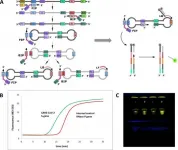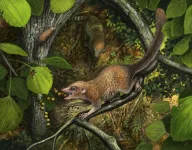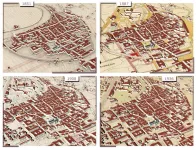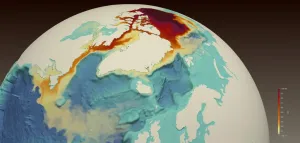(Press-News.org) COLUMBUS, Ohio - Politicization of the COVID-19 pandemic had a powerful influence over adherence to social distancing guidelines in the United States and why people did, or did not, comply during the lockdown days, a new study has found.
The analysis boiled down to whom study participants trusted most: scientists or President Donald Trump.
"People who expressed a great deal of faith in President Trump, who thought he was doing an effective job of guiding us through the pandemic, were less likely to socially distance," said Russell Fazio, senior author of the study and a professor of psychology at The Ohio State University. "In contrast, the people who expressed a great deal of trust in scientists showed the exact opposite pattern: They were more likely to engage in social distancing.
"We were getting two-sided messages at the time from our government officials and public health scientists, so we had these two sources that were, in effect, working in opposition to one another. That pointed to the politicization of the pandemic."
The study is published today (Feb. 24, 2021) in PLOS ONE.
Fazio's lab studies how personal beliefs and attitudes influence behavior. When COVID-19's emergence in the United States led to lockdowns and stay-at-home orders, the national directive to socially distance became an enormous science experiment.
"On the basis of everything we've known for decades of social psychology, it seemed clear that people's pre-existing beliefs would affect their interpretations of the seriousness of the pandemic and the extent to which they would comply with these recommendations," Fazio said. "We thought we needed to directly assess that empirically, find out who was indeed complying or not complying, and get some idea about which beliefs mattered."
According to the authors' theoretical framework, three components were at play when the information campaign began: the source of the message, what kind of challenge the context presented - is the virus really a threat? - and the self-views of the targets, in this case the entire U.S. population.
The researchers recruited participants from Amazon's Mechanical Turk crowdsourcing marketplace. The sample in this study consisted of 2,001 U.S. adults representing a range of ages, geographical locations and political ideologies.
The team surveyed the participants in early May about their personal beliefs on a range of issues associated with the pandemic: how much they trusted the sources of information, the extent of their worry about the dangers of the virus, and how concerned they were for others' vulnerability to getting sick. Did they believe in the value of science, trust the federal government's handling of the pandemic, weigh economic concerns over public health, consider themselves compassionate?
"We were interested in the extent to which an individual had a self-view as a compassionate person, because at least part of the reason we were all engaging in social distancing was to protect one another. We were also interested, because of all of the misinformation that was floating around, in people's general tendency toward conspiratorial thinking," Fazio said.
Questions about beliefs and political leanings were combined with a knowledge check: a true-or-false quiz on 13 facts and myths about the coronavirus.
To gauge participants' social distancing behavior, the researchers presented study participants with 10 virtual behavior scenarios of various public settings - a grocery store, a crowded beach, a crosswalk - and asked them to place themselves or fictional people in those contexts based on their social distancing preferences. Though the researchers also asked participants to self-report their social distancing practices, the virtual scenarios requiring "in the moment" decisions about reactions to different situations were considered more representative of how people actually behaved in real life.
In fact, a recently published study involving follow-up data showed that the more participants demonstrated a preference for social distancing in the virtual scenarios, the less likely they were to have gotten sick with COVID-19 in the subsequent four months - a finding that established the validity of the virtual measures.
Statistical analyses revealed several correlations. Trust in scientists, support for the guidelines, belief that the virus threat was not exaggerated, concern about its spread, general science literacy and COVID-19 knowledge were strongly associated with the practice of social distancing. Trust and confidence in President Trump and the federal government's effectiveness, belief in conspiracy theories, a political lean toward conservatism and an opinion that economic health was more important than safety were linked to lower odds of practicing social distancing.
Fazio said the findings may make one wonder what might have been had the U.S. populace been exposed to more consistent messaging.
"If there had been a single coherent voice communicating information, leading people to understand how serious the threat was and encouraging all of these preventive behaviors, including social distancing, I think we would have seen far more compliance," he said. "That is what comes through the data very clearly."
INFORMATION:
This work was supported by the National Science Foundation. Co-authors include Benjamin Ruisch, formerly an Ohio State postdoctoral researcher now at Leiden University, and graduate students currently in Fazio's lab: Courtney Moore, Javier Granados Samayoa, Shelby Boggs and Jesse Ladanyi.
Contacts:
Russell Fazio, Fazio.11@osu.edu
Benjamin Ruisch, b.c.ruisch@fsw.leidenuniv.nl
Written by Emily Caldwell, Caldwell.151@osu.edu
Ultra-fast, cheap LAMP-based COVID tests could be performed by non-experts at work and in public spaces, giving results in under an hour
INFORMATION:
Article Title: "Ultra-rapid detection of SARS-CoV-2 in public workspace environments"
Funding: This project was made possible through the support of a grant from Dynamic Combinatorial Chemistry, LLC, The funder provided support in the form of salaries and supplies for authors OY, ZY, JM, and BO, but did not have any additional role in the study design, data collection and analysis, decision to publish, or preparation of the manuscript. The specific ...
Improving road safety in cities could result in a lower rate of violent crime, according to research from UCL.
Experts analysing crime and car accident data in Mexico City found a surprisingly high level of synchronicity between the two on a weekly cycle, suggesting that applying more resources to prevent road accidents would improve crime rates by enabling more efficient policing.
For the paper, published today in Cities as Complex Systems special issue in PLOS ONE, experts plotted the time and locations of nearly one million car accidents and 200,000 ...
CLEVELAND, Ohio - Researchers at University Hospitals Rainbow Babies & Children's Hospital (UH Rainbow) published new findings today that wearing a face mask - either a cloth mask or a surgical mask - did not impair the ability of subjects to get air in and out of their bodies.
The study measured heart rate, transcutaneous carbon dioxide tension, and oxygen levels in 50 adult volunteers at the conclusion of six 10-minute phases: Sitting quietly and then walking briskly without a mask; sitting quietly and then walking briskly while wearing a cloth mask; and sitting quietly and then walking ...
WATERTOWN, Mass. - Gene therapy has traditionally been conceptualized as a one-time, curative treatment option; however, research shows that there may be a need for subsequent doses years after initial treatment. While adeno-associated viral (AAV) vectors are a core part of this powerful therapeutic approach, they present two key challenges in gene therapy.
The first challenge is their immunogenicity. In gene therapy, the formation of neutralizing antibodies (Nabs) in response to AAV vector administration precludes retreatment of a patient due to the potentially dangerous immune response that would occur after a second or third administration of the therapy.
The second obstacle relates to their durability. AAV vectors ...
A new study published Feb. 24 in the journal Royal Society Open Science documents the earliest-known fossil evidence of primates.
A team of 10 researchers from across the U.S. analyzed several fossils of Purgatorius, the oldest genus in a group of the earliest-known primates called plesiadapiforms. These ancient mammals were small-bodied and ate specialized diets of insects and fruits that varied by species. These newly described specimens are central to understanding primate ancestry and paint a picture of how life on land recovered after the Cretaceous-Paleogene extinction event 66 million years ago that wiped out all dinosaurs -- except for birds -- and led to the rise of mammals.
Gregory Wilson Mantilla, a University of Washington professor of biology and curator of vertebrate ...
A research team from Skoltech and FBK (Italy) presented a methodology to derive 4D building models using historical maps and machine learning. The implemented method relies on the geometric, neighbourhood, and categorical attributes to predict building heights. The method is useful for understanding urban phenomena and changes contributing to defining our cities' actual shapes. The results were published in the MDPI Applied Sciences journal.
Historical maps are the most powerful source used to analyze changes in urban development. Nevertheless, maps represent the 3D world ...
Freshwater is accumulating in the Arctic Ocean. The Beaufort Sea, which is the largest Arctic Ocean freshwater reservoir, has increased its freshwater content by 40% over the past two decades. How and where this water will flow into the Atlantic Ocean is important for local and global ocean conditions.
A study from the University of Washington, Los Alamos National Laboratory and the National Oceanic and Atmospheric Administration shows that this freshwater travels through the Canadian Archipelago to reach the Labrador Sea, rather than through the wider marine passageways that connect to seas in Northern Europe. The open-access study was published Feb. 23 ...
Emerging smart mobile health (or mHealth) technologies are changing the way patients track information related to diagnosed conditions. A new study examined the health and economic impacts of mHealth technologies on the outcomes of diabetes patients in Asia. The study concluded that compared to patients who did not use mHealth applications, patients who used the apps had better health outcomes and were able to regulate their health behavior more effectively. They also had fewer hospital visits and lower medical costs.
The study was conducted by researchers at Carnegie Mellon University (CMU) and New York University ...
New Orleans, LA -- A new study of how the 2020 major hurricanes and the COVID-19 pandemic affected each other as well as disaster response found that although prior experience enabled community-based organizations to respond to the pandemic, the pandemic is also creating new challenges to preparing for and responding to natural disasters. The research is published in the International Journal of Environmental Research and Public Health, available here.
"Two major crises hit Louisiana and coastal communities in the Southeastern United States in 2020 - a significant increase in the frequency and severity of hurricanes, and the COVID-19 pandemic," says Benjamin Springgate, MD, MPH, Chief of Community & Population Medicine at ...
A study aiming to develop a new therapeutic technique could bring a revolution in our approach to treating rare, fatal Sanfilippo syndrome, a disorder that affects children as young as 2 years old and leads to childhood dementia and premature death.
"We are using a combination of gene therapy, stem cells and small molecules to restore metabolic defects in the patient's brain cells" says Dr. Alexey Pshezhetsky, Professor at CHU Ste-Justine and lead GlycoNet Investigator on this project. "First results in the mouse models of the disease are very encouraging."
Sanfilippo syndrome belongs to a group of rare diseases known as lysosomal storage disorders.
The syndrome occurs in ...



